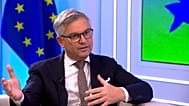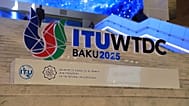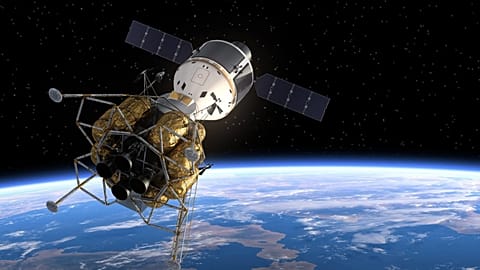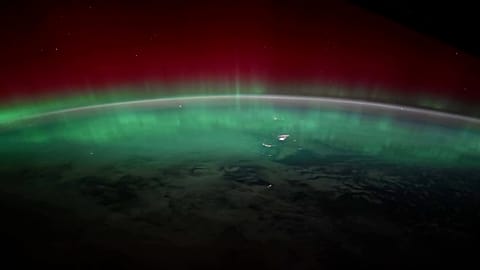These are the European Space Agency’s new top 4 space priorities.
The European Space Agency (ESA) has set its priorities for the next three years, backed by a higher €22.1 billion budget in fresh commitments from its member states.
Ministers of all ESA’s member states descended on Bremen, Germany, to decide which space programs they want to “subscribe” to or contribute to and how much money to give over the next three years in a tri-annual meeting that sets the course for Europe in space.
Josef Aschbacher, the ESA’s director general, said the support from member states is an “expression of confidence,” at a time when several modern space races are on.
“It shows that space is extremely attractive, extremely needed for society for everyday life and that it is growing very fast in Europe,” he said in a press conference.
Here are some of the priorities that the ESA identified during its meetings.
1. Finding life on Saturn’s moons
The new budget means the ESA can potentially launch new research programmes, such as a mission to Enceladus, Saturn’s sixth-largest moon.
Aschbacher said that ESA would eventually like to fly to Enceladus, land and take probes onto the landscape to look for signs of life.
“Exobiologists say if you are looking for signs of life in space, this is where you would look,” Aschbacher said. “Imagine what this means if we can find traces of life”.
However, Aschbacher said it will be a while until the ESA is ready to take on this mission, but it will be studying how it can get there.
Another project that ESA will continue working on after the ministerials is NewAthena. The ESA describes it as the largest X-ray observatory ever built.
The machine will eventually help scientists study “some of the hottest and most energetic phenomena in the Universe with unprecedented accuracy and depth,” according to a description of the project.
The mission is currently being studied and costed with a decision to “adopt” it by 2027, Aschbacher said.
2. German, French, and Italian astronauts bound for the Moon
According to German media, Aschbacher announced on the sidelines of the ministerials that German, French, and Italian astronauts will eventually take part in the Artemis missions to the Moon.
Aschbacher reportedly told the media that Germany would be the first in line for a seat on future missions, but did not specify who might be selected.
The Artemis missions are humanity’s return to the Moon’s surface for the first time since the 1960s. Artemis II will bring four astronauts around the Moon and back down to Earth, while Artemis III will see two astronauts descend to the Moon’s surface to conduct experiments on its South Pole.
While the lead space agency for the Artemis missions is the United States’ National Aeronautics and Space Administration (NASA), the ESA manufactured key components of the Orion spacecraft that will bring the astronauts into orbit.
3. New European space centres to come in Norway, Poland
On the sidelines of the ministerial, ESA signed a letter of intent with Norway to open a space centre in the Arctic.
The agreement means a joint working group will be set up with the Norwegian Space Agency (NOSA) to come up with the centre’s proposed scope, priorities and governance model by the end of next year.
Cecilie Myrseth, Norway’s minister of trade and industry, said in a statement that the space centre is an acknowledgement that the country is a “space nation,” and will have a “major impact” on space technology used for communication, surveillance and navigation.
Tromso in particular is the mission control base for ESA’s Arctic Weather Satellite, a constellation of satellites orbiting the North Pole that provides data for short-term weather forecasts.
Aschbacher said a space security centre is also being considered in Poland that will support “efficient and coherent development of European space security and resilience capabilities”.
The new centre would complement work already being done at the European Space Security and Education Centre (ESEC) in Belgium, a press release after the ministerial said.
Polish representatives and the ESA will figure out the technical requirements and funding for the centre and will decide on the outcome by 2026.
4. Deepening global partnerships
Aschbacher pointed out that ESA’s partnerships with like-minded states, such as Canada, Japan, South Korea and Australia, are “stronger than ever.”
The Canadian delegation got a mention from Aschbacher during the ministerial press conference after boosting its ESA contribution to $664.6 million (€407.7 million), a 400 per cent increase from 2022.
The country has had a cooperation agreement with the ESA since 1979, which gives it some of the same rights as a member state, such as being able to bid on government contracts.
Aschbacher said ESA will find ways to boost collaboration with Japan, South Korea and Australia, which shows that the ESA is a “strong partner” within Europe and for the rest of the world.
Italian minister Adolfo Urso said he will soon be heading to the US to see whether ESA can continue to count on American contributions to the agency.
NASA’s recent budget cuts and programme reorganisations have raised concern at ESA earlier this year, which warned that up to 19 US-EU projects could be at risk.
Aschbacher confirmed this week that NASA agreed to continue funding until 2028 at least, one of these at-risk missions, called the Rosalind Franklin ExoMars Rover mission.
This is an ESA programme that drills down to the surface of the Red Planet to dig up organic material for further scientific study.


















